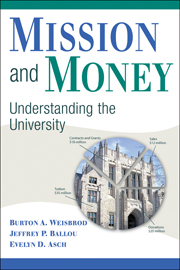Book contents
- Frontmatter
- Contents
- Illustrations
- Preface
- 1 An Introduction to the Higher Education Industry
- 2 The Higher Education Business and the Business of Higher Education – Now and Then
- 3 Is Higher Education Becoming Increasingly Competitive?
- 4 The Two-Good Framework: Revenue, Mission, and Why Colleges Do What They Do
- 5 Tuition, Price Discrimination, and Financial Aid
- 6 The Place of Donations in Funding the Higher Education Industry
- 7 Endowments and Their Management: Financing the Mission
- 8 Generating Revenue from Research and Patents
- 9 Other Ways to Generate Revenue – Wherever It May Be Found: Lobbying, the World Market, and Distance Education
- 10 Advertising, Branding, and Reputation
- 11 Are Public and Nonprofit Schools “Businesslike”? Cost-Consciousness and the Choice between Higher Cost and Lower Cost Faculty
- 12 Not Quite an Ivory Tower: Schools Compete by Collaborating
- 13 Intercollegiate Athletics: Money or Mission?
- 14 Mission or Money: What Do Colleges and Universities Want from Their Athletic Coaches and Presidents?
- 15 Concluding Remarks: What Are the Public Policy Issues?
- Appendix
- References
- Index
1 - An Introduction to the Higher Education Industry
Published online by Cambridge University Press: 17 July 2009
- Frontmatter
- Contents
- Illustrations
- Preface
- 1 An Introduction to the Higher Education Industry
- 2 The Higher Education Business and the Business of Higher Education – Now and Then
- 3 Is Higher Education Becoming Increasingly Competitive?
- 4 The Two-Good Framework: Revenue, Mission, and Why Colleges Do What They Do
- 5 Tuition, Price Discrimination, and Financial Aid
- 6 The Place of Donations in Funding the Higher Education Industry
- 7 Endowments and Their Management: Financing the Mission
- 8 Generating Revenue from Research and Patents
- 9 Other Ways to Generate Revenue – Wherever It May Be Found: Lobbying, the World Market, and Distance Education
- 10 Advertising, Branding, and Reputation
- 11 Are Public and Nonprofit Schools “Businesslike”? Cost-Consciousness and the Choice between Higher Cost and Lower Cost Faculty
- 12 Not Quite an Ivory Tower: Schools Compete by Collaborating
- 13 Intercollegiate Athletics: Money or Mission?
- 14 Mission or Money: What Do Colleges and Universities Want from Their Athletic Coaches and Presidents?
- 15 Concluding Remarks: What Are the Public Policy Issues?
- Appendix
- References
- Index
Summary
Higher education affects almost all of us – as students, parents, employees, employers, and citizens or as beneficiaries of scientific, medical, and technological research. A college education is coming ever closer to being considered so basic that, like hospital care, it is too important to be left to the competitive forces of the marketplace.
Higher education today is caught up in conflicting political pressures that are increasingly relying on it to solve economic and social problems. Colleges and universities are called on to expand their already broad missions and make college education available not only to all recent high school graduates but also to older adults trying to adjust to changing labor markets. At the same time, higher education is asked to expand these educational services while reducing revenue from tuition and to avoid pursuit of other revenue sources when they involve questionable relationships with the corporate world. And the richer schools are pushed to spend down endowments that are being deemed “excessive” without a clear definition of what that means.
The higher education industry is complex and diverse. It combines a dominant public sector of state universities and community colleges that educate a majority of all students; a varied private sector of nonprofit schools that encompass some of the world's most elite research universities, such as Harvard, Princeton, and Stanford; elite liberal arts colleges, such as Swarthmore and Williams; and many hundred less-selective schools, many religiously oriented.
- Type
- Chapter
- Information
- Mission and MoneyUnderstanding the University, pp. 1 - 8Publisher: Cambridge University PressPrint publication year: 2008

